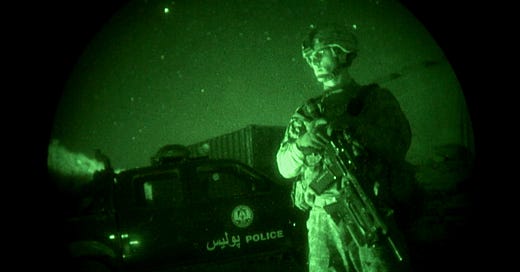Taliban Terror II: The Insurgency
Why the US was unable to stamp out the Taliban in Afghanistan.
The following is the second of three articles titled “Taliban Terror.”
Ten years into the war in Afghanistan, the US was no closer to victory than when it first arrived. Over 2,700 Coalition troops had been lost. Close to half a trillion dollars had been spent. Even still, the Taliban continued to gain ground.
Kill or capture
But Obama had a plan. After attempting a troop surge in 2009, the president prepared to wind down and hand over sovereignty to the new Afghan government by 2014. The mission shifted. Instead of thousands of boots on the ground, the US now adopted a more high tech approach. Drones assaulted the terrorists from the air. Large counterinsurgency operations were abandoned in favor of smaller task forces, who targeted insurgent leaders. It was known as “kill/capture.” But it backfired, only strengthening support for the Taliban. Initially, the raids were done in secret. But on May 2, 2011, after Special Forces assassinated bin Laden, the scope of the raids became widely known. Senior Taliban leaders were detained or killed. General Petraeus embraced the new strategy, and raids increased sixfold. By 2010, 10 to 15 operations were conducted each night. Drones, surveillance, and reconnaissance were forcefully deployed. But as terrorist cells were closed down, new ones sprung up in other places. It became a frustrating cat-and-mouse game. Mistaken raids annoyed the innocent Afghan population. Even as US troops continued these risky operations, the Taliban adapted their tactics accordingly. The night raids were very unpopular among the Afghans, sometimes turning them against the Americans. Civilians were accidentally killed, including children. President Karzai was outraged, and publicly spoke out against the raids. Petraeus attempted to reduce the civilian casualties. But there was no doubt that the raids had backfired disastrously.
Carrot and stick
Amid growing concerns that the war was failing, the Pentagon secretly kept up negotiations with the Taliban. But General Petraeus postponed direct talks, hoping to only do so at an ideal future time. US ambassadors pushed for peace talks between Karzai’s government and the Taliban at Doha, Qatar. But the Taliban simply exploited the opportunity to project its diplomatic and political independence from the Afghan government. The Taliban referred to their state as the Islamic Emirate of Afghanistan. As talks fell apart, the Taliban cleverly negotiated the release of five of their prisoners, in exchange for a single US prisoner. It was disastrous. Obama made a surprise visit to Afghanistan ahead of Memorial Day of 2014. The president sounded optimistic. He was convinced that the Afghan security forces were sufficiently trained and equipped to manage the Taliban threat. Nearly 70,000 troops had returned back to America. By the end of the year, the war in Afghanistan appeared to draw to a close. In December, the Coalition formally handed over sovereignty to the Afghan government. This marked a new phase in the war, called Operation Resolute Support. US forces would now play only an advisory and training role in Afghanistan.
“Ghost soldiers”
After serving two terms as president, Karzai was replaced with a new elected leader. His name was Ashraf Ghani. An academic from the World Bank, he co-wrote the book Fixing Failed States. Ghani was a charismatic leader with excellent oratory, but he also had a large ego. His attitude was condescending and patronizing. He had a tendency to micromanage others. But beyond Ghani’s personal foibles, the Afghan government was not prepared for independence. Afghan security forces were corrupt and weak-willed. Attrition rates were as high as 30%. Despite being the largest employer in the entire country, the Afghan security forces were still not able to amass the needed numbers to sustain an army. Wages were too low. Some soldiers never received their salaries. Attendance data was unreliable, meaning that no one knew how big the forces actually were. This phenomenon became known as “ghost soldiers.” Afghanistan’s corrupt bureaucrats happily snatched up American dollars that were allocated for Afghan troops. It was discovered that the US spent $300 million to Afghan soldiers that might not even have existed. Defense ministers embezzled funds to purchase luxury homes in Germany, Turkey, the US, and the Middle East. The feeble Afghan army would face their first test in the northeastern province of Kunduz. The city fell with almost no resistance on September 28, 2015. It was the Taliban’s biggest victory in fourteen years of war. Hundreds of prisoners were unleashed. Revenge killings broke out. A third of the Afghan army had either deserted, or else did not exist at all. They were ghost soldiers. Things only got worse after an American AC-130 gunship fired on the wrong target, destroying Kunduz’s only hospital with 211 shells. 42 people died, including 24 patients and 14 Doctors Without Borders staff. Patients burned up in their beds. There were demands to investigate war crimes. The Afghan government justified the attack, which only diminished its legitimacy further. The Taliban’s assault was a massive victory, exposing the weakness and fragility of Ghani’s government forces. They continued to gain ground. The prospect of an Afghan future without the Taliban only grew bleaker and bleaker.
Learn More





